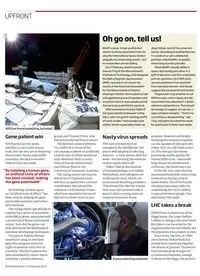
2013 Immunotherapy could help against new coronavirus PDF
Preview 2013 Immunotherapy could help against new coronavirus
4 | NewScientist | 23 February 2013 maximilien brice/cern YOUR genes are the same, whether in a test tube or your body. But the very act of removing them makes them a patentable invention, decreed Australia’s Federal Court last week. By isolating a human gene, an “artificial state of affairs” has been created, making the gene patentable material, said Justice John Nicholas. The ruling relates specifically to a patent for a series of mutations in the BRCA1 genes, associated with a raised risk of breast and ovarian cancer. Tests for the genes can help determine the likelihood of someone developing the diseases. The patent, filed by Myriad Genetics in 1994, in principle gives the company exclusive rights to perform such tests in Australia. The firm’s patent was later contested by Cancer Voices Australia, a patient advocacy Gene patent win group, and Yvonne D’Arcy, who had previously had breast cancer. The decision raised eyebrows. “It is difficult to think of the circumstances where an artificially created state of affairs would not exist whenever there is some form of human intervention,” says Dianne Nicol at the University of Tasmania, Australia. The ruling comes two months before the US Supreme Court will hear an appeal over a similar case between Myriad and the American Civil Liberties Union, which was awarded in favour of Myriad in a lower court in 2011. Nasty virus spreads THE new coronavirus that emerged in the Middle East last year is well adapted to infecting humans – a sixth person died this week – but boosting the immune system could ward it off. Volker Thiel at the Institute of Immunobiology in St Gallen, Switzerland, and colleagues are studying the virus, which can cause severe breathing problems. They found that, like the viruses that cause the common cold, it doesn’t elicit a strong immune response in human tissue samples. However, artificially boosting the immune response cut the number of infected cells (mBio, DOI: 10.1128/mBio.00611- 12). This therapy also shows promising results against the related SARS virus – and could help reduce the likelihood of outbreaks, the researchers say. In the UK, a 60-year-old man was hospitalised after contracting coronavirus during a trip to Saudi Arabia. Two of his family members have since fallen ill, underlining the virus’s ability to spread between people. One died earlier this week. LHC takes a break FRESH from its discovery of the Higgs boson, the Large Hadron Collider is taking a two-year break. But there is no vacation for the engineers who run the collider, nor the physicists who crunch its data. Since 2009, the LHC, at CERN near Geneva, Switzerland, has mostly been smashing together two beams of protons. The beams each reached peak energies of 4 trillion electronvolts, enough to discover the Higgs, the particle –AMS has found something, but what?– –Superconducting makeover– Oh go on, tell us! WHAT a tease. A high-profile dark matter-hunting experiment that sits atop the International Space Station allegedly has interesting results – but its researchers are not telling. On 17 February, Nobel laureate Samuel Ting of the Massachusetts Institute of Technology, who designed the Alpha Magnetic Spectrometer (AMS), was due to announce the results at the American Association for the Advancement of Science meeting in Boston. But instead he told a disappointed group of reporters and scientists that his team would wait till the work was published in a journal. AMS launched on the last flight of the space shuttle Endeavour in May 2011, with the goal of catching whiffs of exotic matter. That includes dark matter, which supposedly makes up about 80 per cent of the universe’s matter. According to leading theories, it is made of as-yet-undetected particles called WIMPs, or weakly interacting massive particles. These WIMPs should collide in space, destroying each other in a puff of electrons and their antimatter partner, positrons. So if AMS picks up more positrons than expected from normal processes, that would suggest the presence of dark matter. Ting wouldn’t say whether or not AMS has seen such a signal, but did reveal that it has detected 7.7 billion electrons and positrons. That should be enough to suggest, or rule out, a signal at lower energies. “There’s no such thing as disappointing,” said Ting, who plans to submit the work for publication in about two weeks. “By isolating a human gene, an artificial state of affairs has been created, making the gene patentable” nasa UPFrOnT 130223_N_Upfront.indd 4 19/2/13 17:12:03
